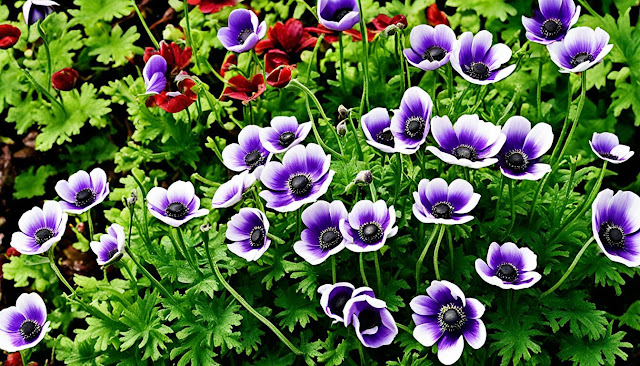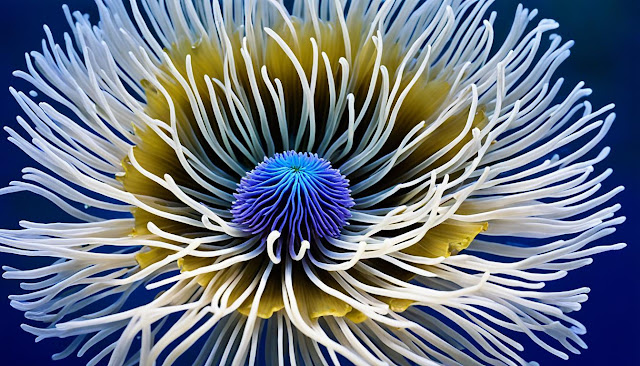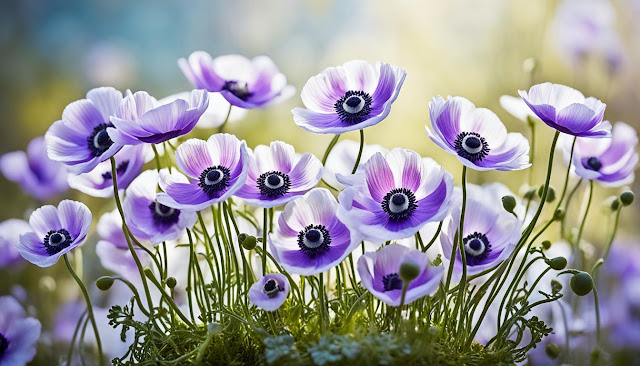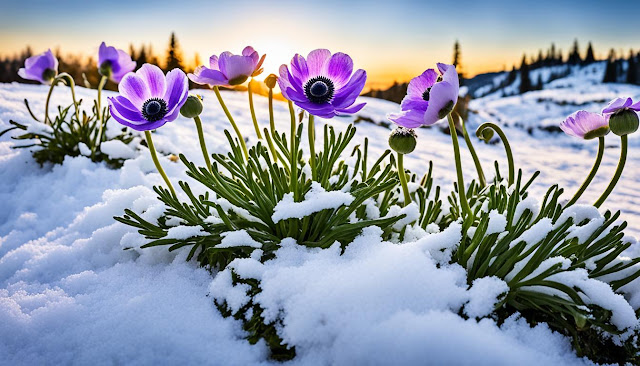 |
| anemone |
Anemones are truly fascinating and versatile plants. They bring amazing beauty, from bright garden flowers to the fine sea life. Anemones catch our eyes with their rich colors and detailed shapes. But what do these plants mean for the world of nature and our gardens?
We invite you to dive into the world of anemones with us. You may be a garden lover wanting to add more beauty outside. Or perhaps you're into fish tanks and find ocean life amazing. Anemones have a lot to offer for anyone looking to learn and be amazed.
- Anemones offer a diverse range of beauty in both gardens and sea gardens.
- They play significant roles as pollinators and providers of shelter in ecosystems.
- Anemone flowers and sea anemones have distinct characteristics and habitats.
- Growing and caring for anemone flowers requires attention to soil, light, and water requirements.
- Sea anemones form fascinating symbiotic relationships and can be cared for in home aquariums.
Introduction to Anemone: Nature's Diverse Beauty
This section looks at the beauty of anemones. We cover garden flowers and sea types. We dig into their roles in nature and gardens, like as pollinators.
We also explore what makes them different and special. This helps us see how they fit in their habitats.
Understanding the Different Types of Anemones
Anemones are varied and beautiful. In gardens, you'll see flowers like the pink Anemone coronaria. Or the red Anemone hupehensis which adds brightness and beauty.
Sea anemones are also amazing. They live in oceans and stand out with their tentacles. They are homes for small sea creatures.
The Significance of Anemone in Ecosystems and Gardens
Anemones are key to many ecosystems. For example, sea anemones offer homes for fish. This helps keep ocean life diverse and rich.
In gardens, anemones attract important pollinators. These include bees and butterflies. They help keep plant species thriving.
Anemone Flower vs Sea Anemone: Unraveling the Mystery
Anemone flowers and sea types are very different. Garden anemones need soil, sun, and water. They make gardens more beautiful and attract pollinators.
Sea anemones live in water and catch prey with their tentacles. They are known for their bright colors underwater. Both types are very unique.
How to Grow and Care for Anemone Flowers
 |
| anemone corms |
Choosing the Right Anemone Corms for Your Garden
Before you begin growing anemone flowers, pick the proper anemone corms. These are bulb-like structures full of potential for beautiful flowers. When choosing, think about these tips:
- Hardiness: Pick corms that match your climate to help them grow strong.
- Color and Variety: There are many colors and types of anemone corms. Choose ones that add to your garden's look.
- Size: Consider how big the anemone plants will get. This helps you place them well in your garden.
- Quality: Always choose high-quality corms. They should be firm, plump, and undamaged.
Soil, Light, and Water: Essentials for Anemone Flower Care
After selecting the right corms, give them the best environment for growth. These elements are key for caring for anemone flowers:
- Soil: Anemones love well-draining, organic-rich soil that's slightly acidic or neutral.
- Light: They usually need full sun to partial shade. Make sure they get enough light.
- Water: Anemones like consistent but not excessive moisture. Water regularly, adjusting as needed.
When and How to Plant Anemone Bulbs for Optimal Bloom
To get the most out of your anemone flowers, timing and planting method are crucial:
Plant anemone bulbs in early fall, 4-6 weeks before the first frost. Here's how:
- Clear the soil of weeds and loosen it up to 6-8 inches deep.
- Soak the corms in water for several hours to rehydrate them.
- Plant them 2-3 inches deep with the pointy side up.
- Follow the spacing advice for your anemone type.
- Top the corms with soil and lightly press them in.
- Water well after planting to help them start growing.
By doing all these steps, you pave the way for a beautiful anemone flower display in your garden.
Battling Challenges: Dealing with Anemone Plant Diseases and Pests
 |
| anemone pests |
Having a healthy garden means facing problems, and anemones are not left out. These pretty flowers can get sick or attract pests. This section shows the main diseases and pests that bother anemones. We will also talk about how you can identify and treat them to keep your anemones bright and beautiful.
Identifying Common Anemone Diseases and Their Treatment
Anemones get sick in many ways, like with fungi, viruses, and bacteria. Knowing the signs early is key to stopping the disease from spreading. Here are the main anemone diseases to watch out for:
- Crown Rot: A fungal disease that rots the plant's base. Look for wilting, yellow leaves, and a bad smell. To fix it, cut out diseased plants and better the water drainage.
- Powdery Mildew: This fungal disease looks like white powder on plants. It weakens them over time. Remove affected parts and improve air flow. Only use sprays as a last resort.
- Rust: This fungi makes orange or brown spots on plants. It slows growth. Remove infected leaves, don’t water from above, and use fungus killer if needed.
For these diseases, good gardening habits and sometimes natural sprays help. Follow the advice for each disease closely. This will give your anemones the best chance to recover.
Natural and Effective Pest Control Solutions for Anemones
Not just diseases, pests can also hurt anemones. Control pests without harming the environment. Here's how:
- Handpicking: Regularly check your anemones and remove pests like aphids by hand. This works well for small gardens.
- Neem Oil: Use neem oil spray to keep pests like aphids away. Remember to mix it as directed on the bottle.
- Companion Planting: Planting marigolds or lavender near your anemones can repel pests. It makes your garden healthier.
These methods reduce pests without using chemicals. Keep an eye on your plants and change your pest control approach as you need. This ensures your anemones stay pest-free longer.
| Pest | Identification | Treatment |
|---|---|---|
| Aphids | Tiny green or black insects that cluster on the leaves and stems | Handpick or use neem oil to control aphid populations |
| Slugs and Snails | Slime trails and irregular holes on leaves | Set up traps or use copper barriers to deter slugs and snails |
| Caterpillars | Chewed leaves and visible caterpillars | Handpick or use organic insecticides specifically designed for caterpillar control |
By learning about and effectively treating anemone diseases and pests, your garden will thrive. Encourage a balanced environment. Use natural pest control and care practices. Your anemones will thank you with their beauty.
Exploring the Underwater World of Sea Anemones
 |
| sea anemone |
Let's journey into the spellbinding realm of sea anemones. You can spot these captivating beings in oceans all over the globe. They dazzle with their unique array of colors and shapes, ranging from bright reds and oranges to soft pinks and purples.
The symbiosis sea anemones share with other sea creatures is truly remarkable. They provide a safe space within their tentacles. Here, relationships with creatures like clownfish and shrimp flourish. This perfect balance in nature highlights how all life in the sea is connected.
Caring for sea anemones at home is a detailed job. They need special care in aquariums that replicate their natural living space. This includes keeping the water temperature and salt levels right, as well as choosing the best light and food. A proper home is key to their happiness and health.
| Species of Sea Anemone | Unique Characteristics |
|---|---|
| Tube Anemone | Forms long tubes for protection and filter feeding. |
| Carpet Anemone | Large and colorful, often hosting clownfish species. |
| Rock Anemone | Adheres to rocks, creating a striking display with vibrant colors. |
| Giant Green Anemone | Impressive size and green coloration found in rocky coastal areas. |
| Long Tentacle Anemone | Graceful, elongated tentacles and captivating colors. |
Learning about sea anemones gives us a richer understanding of the sea's complexity. Be it in the wild oceans or our aquariums at home, these creatures spark amazement and curiosity.
Propagating Anemones: From Seeds to Division
 |
| propagating anemones |
Want to grow your anemone garden? This part will show you how. You can grow new plants for a better-looking garden. There are two ways to do this: with seeds or by dividing corms.
Growing from seeds is fun and lets you create new plants easily. Here is how to do it:
- Get good soil. Fill your pots with it. Anemone seeds need this to grow well.
- Plant the seeds and cover lightly with soil.
- Keep the soil moist but not too wet. This helps the seeds to sprout and grow.
- Put the pots in a warm, sunny spot. Anemone seeds need light and 60-68°F to grow.
- Watch for tiny plants in 1-3 weeks. Give them enough water and light.
- When they have leaves, move them to bigger pots or the garden. Use good soil.
- Water them often and protect from very cold or hot weather.
- Soon, your anemones will bloom, making your garden beautiful.
Dividing Anemone Corms: A Step-by-Step Guide
You can also grow anemones by dividing their corms. It's a great way to add more plants to your yard. Here's how:
- Do this in late fall or early spring, when anemones are not growing.
- Dig up the corms carefully so you don't harm them.
- Clean off the extra soil gently.
- Check the corms for health. If they look bad, throw them away.
- Cut the corms into pieces with a clean knife. Make sure each piece has a bud.
- Choose a spot with good soil for planting.
- Bury the pieces with the buds facing up.
- Water them well. Keep them moist and in a place with enough light.
- Soon, your divided corms will grow and bloom. It's your reward for good care.
Anemone Throughout the Seasons: Ensuring Year-Round Beauty
 |
| anemone throughout the seasons |
Anemones make any garden beautiful by showing off their bright colors and pretty flowers all year. By picking anemones that bloom in different times, your garden can always look lively. We'll check out anemones that love spring and those that shine in the fall.
Which Anemones Bloom in Spring and Which Thrive in Fall?
Spring brings many anemones into bloom, brightening your garden. The Anemone blanda, or Grecian windflower, is a beloved spring anemone. Its flowers come in pretty colors like white, blue, and pink, adding beauty to any space.
The Anemone coronaria, also known as the poppy anemone, is another. It blooms in colors like red, pink, purple, and white. Perfect for bringing bold colors to your flower beds or pots.
Fall has its own charming anemones, like the Anemone x hybrida 'Honorine Jobert'. These have striking white flowers with dark centers. They really stand out before winter sets in.
The Anemone japonica, or Japanese anemone, is a fall favorite too. These elegant plants have pink and white flowers, making your autumn garden magical.
Caring for Your Anemone Post-Bloom: What to Do When Flowers Die Back
After anemones bloom, they need special care to stay healthy. Here are some steps to follow:
- Remove dead flowers: Take off the dead flowers to help your plant grow stronger, not make seeds.
- Prune back foliage: When the leaves turn yellow, cut them down. This lets the plant save energy for later growth.
- Mulch the area: Put mulch around your anemones to protect them during the cold. This keeps the soil just right for them.
- Monitor moisture: Even in winter, check the soil to keep it moist but not too wet. Water your anemones as needed.
Following these steps will help your anemones stay healthy. They'll be ready to bloom beautifully again.
| Spring-Blooming Anemones | Fall-Blooming Anemones |
|---|---|
| Anemone blanda (Grecian windflower) | Anemone x hybrida 'Honorine Jobert' |
| Anemone coronaria (poppy anemone) | Anemone japonica (Japanese anemone) |
Conclusion
From beautiful garden flowers to stunning sea creatures, anemones have won over many hearts. We've looked at how anemones add beauty and meaning to various places, from gardens to the sea.
Anemones bring joy all year, with different types for spring and fall. With the right care, gardeners can keep their outdoor spaces beautiful. This includes choosing anemone corms carefully and giving them the right soil, light, and water.
Under the sea, anemones show their amazing colors and forms. They have special bonds with fish and other sea life. People who love the sea can learn to care for anemones in aquariums. This helps them thrive and brings beauty to their space.
To sum up, anemones show the amazing variety and delicacy of nature. Whether in a garden or an aquarium, they never fail to impress. Anemones teach us about the incredible design of the natural world. They are both beautiful and fascinating, no matter where they are.
